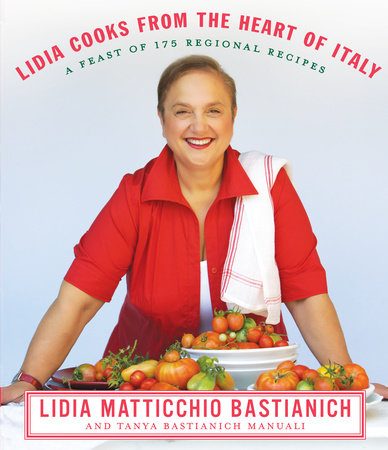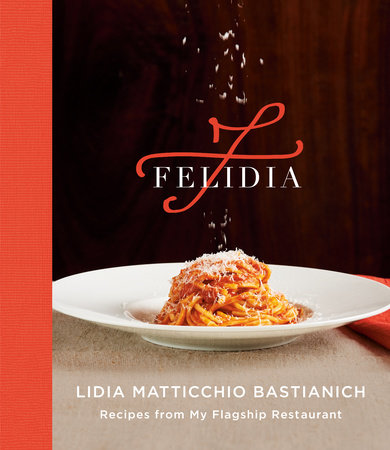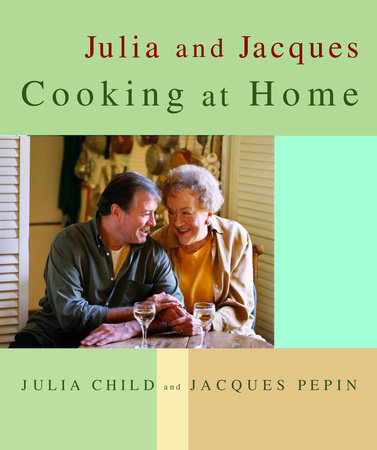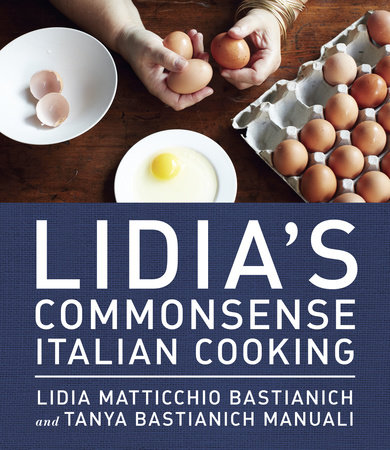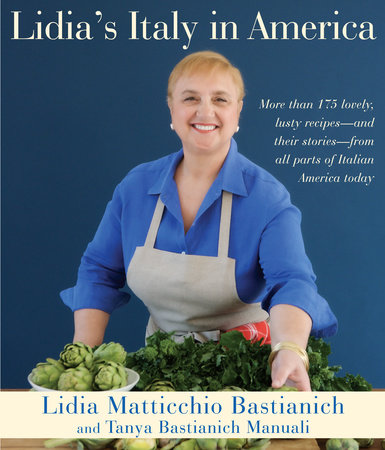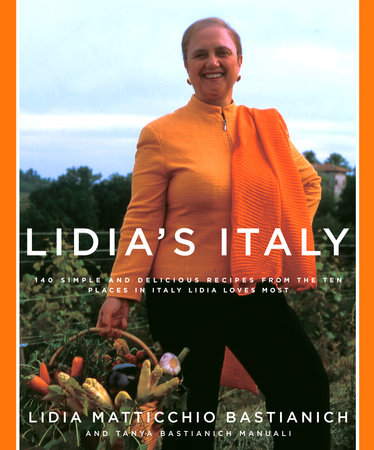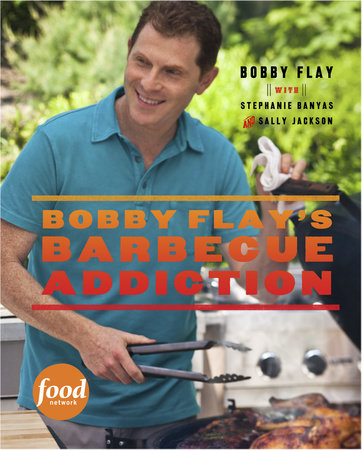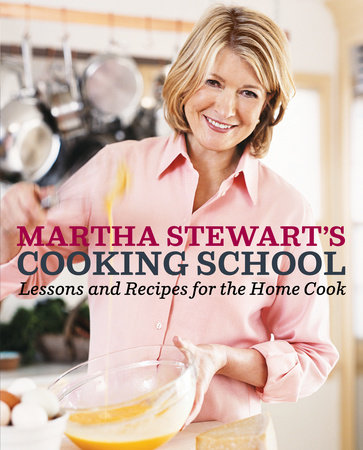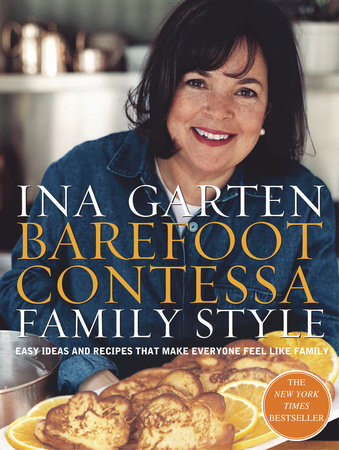Q: We have been learning from you through your cookbooks and your Public Television series for almost a decade now. What new recipes, tips, and lessons do you have to share in LIDIA’S ITALY? Did you learn anything new while creating this book and the series?
A: There is so much in the Italian culinary tradition, that it amazes me. Every time I go back to Italy and visit another corner, I learn dozens upon dozens of recipes. And today’s consumer is ever more educated about food. Cookbook readers want to be challenged by a recipe, and hence recipes that were once considered too traditional, such as "Bigoli" pasta from the Veneto or "Antico Peposo" braised beef with crushed peppercorns, from Maremma, are sought out today.
Q: As we learned in your previous cookbook, Lidia’s Family Table, your entire family is involved in creating meals. But what was it like to collaborate with your daughter Tanya to write LIDIA’S ITALY?
A: For me to share and collaborate with my children is the greatest reward as a mother and a business woman. To have my children follow my passion and build upon it with their knowledge, spirit and passion affirms to me that they understand and appreciate my art and passion and want to carry on the tradition. My daughter’s passion for and knowledge of Italian art history is a natural compliment to Italian food and life. It is Italy!
Q: Italians are very proud of their home regions and the heritage of their region. You’ve brought the traditions of many different regions together in this cookbook — what trends are present throughout the peninsula? Are there key distinctions among the regions?
A: There is a universal appreciation of traditional regional cuisine, in every region of Italy, the longing for "La Cucina Della Nonna" or grandma’s cooking. Having said that, the current trend is to support artisan food makers. People in Italy will travel in search of the best cheese mongers, pasta makers, olive oil producers and pay top prices for such quality.
Q: How are the culinary traditions you describe in the book influenced by surrounding cultures?
A: Italy is a small, long peninsula with many borders through which various influences filtered into the Italian culinary culture, from the Slavic influence in the northeast to the Germanic influence to the north and the French in the west. The coasts of Italy received many passing visitors, and with them their flavors–Greek, Arab, Moorish, which can still be tasted in today’s southern Italian cuisine.
Q: How did you start cooking and when did you know it was your calling?
A: I always loved being around food. I loved preparing and cooking it, as well as growing and producing it. As a child, I helped my grandma Rosa tend her garden, feed the animals and prepare the vegetables, eggs and cheeses to sell at market. I would also stay by her side when she cooked, helping her knead bread and make pasta and gnocchi. For me, touching and preparing food always felt good. I can still recall the silkiness of the pasta dough she made and strive for that texture when I make pasta at home and at my restaurants. Being introduced to food at a very young age, and carrying these culinary traditions with me, I’m sure had a great deal to do with my chosen profession.
Q: How did your life change when your family moved from Italy to New York City?
A: It was a jolting change of gears from a tranquil, pastoral setting to the urban rhythms of a big city. For me, it was very exciting and challenging, but I was always nostalgic for my grandma and the friends I left behind. As Istria became part of communist Yugoslavia and the iron curtain went down, we were not allowed to leave or migrate and one member of the family had to remain in Istria as a hostage to ensure that the family would return. But my mother and father had a plan. My mother, brother Franco, and I went back to Italy, supposedly to visit the part of the family that was left in Italy. My father, who remained, escaped past the border during the night while being shot at, to join us in Trieste. I was heart broken because I did not have the chance to say good-bye to grandma and my friends.
Q: You opened your first restaurant at the age of 24. What was it like when you started out?
A: I knew I loved food and cooking and that people enjoyed what I cooked, but at that early age I didn’t have the knowledge and wasn’t savvy enough to run a restaurant. But sometimes passion pushes us to forge beyond our expectations. I was very excited, and I felt challenged. I recall being amazed that there were lines of people waiting to eat my food. I was thrilled that I could share the food of my heritage with complete strangers and that they would enjoy and appreciate it. Over time, a bond developed, and I am still amazed at the trust and loyalty my clients have for me. I’m lucky. I have been cooking professionally for over thirty years, and some of my first customers still visit with me at my restaurants today.
Q: In the cookbook, you talk a lot about your family. How has the energy and stimulation that you have received from your family shaped your culinary heritage and business?
A: My family sustains me. They are the basis of my being and the source of my strength. Their love and support gives me the will to work, to create, to move mountains. In the Italian culture, family is the very essence and center of our existence. I was very lucky to have my mother by my side from the first day I opened my restaurant. She was there to help me work, to help me raise my children, and to see me through rough periods. She still lives with us, and in turn I am blessed that my two children and their families are very close to me. We work together in what is now a family business of restaurants, wines, sauces, cookbooks and television.
Q: Besides being a chef, you are a business woman, running several successful restaurants in the US, owning the Bastianich wineries in Italy, and creating products like sauces. Was this a natural progression for you?
A: My business growth has had a natural evolution. The next step and next investment is always rooted in the security and knowledge of the past. Every opportunity has come from an existing business reality.
Q: What is your favorite dish?
A: I do not have one favorite dish. That is like asking me which is my favorite child. I love them all the same, but for different reasons, and at different times. But if I were stranded on a deserted island, give me pasta for the rest of my life and I would be happy.
Q: What’s next for you?
A:I hope to continue on my path of sharing and educating Italian culture with my restaurants, a new book and series, possibly a children’s cookbook and TV series, expanding my food line "Lidia’s Flavors of Italy" and working with my foundation and other charities to make the world a better place for all where hunger does not exist.
